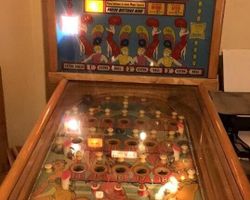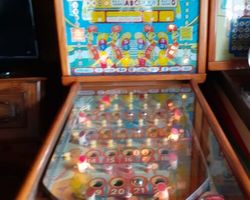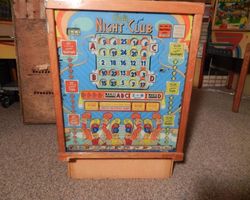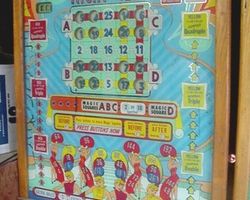Night Club

Average Prices: USD $300 to $1,000
Produced: 0
Machine Type: Electro-mechanical
Players: 1
Design by: Don Hooker
Bally Manufacturing Corporation, a name synonymous with innovation in the coin-operated entertainment industry, released the "Night Club" pinball machine in 1956. This electro-mechanical (EM) bingo machine, designated Model Number 577, emerged during a vibrant era for such devices, when they offered a distinct experience from traditional flipper-based pinball. The game's theme, reflecting the sophistication and allure of a bustling nightlife, was a popular choice that resonated with the era's cultural landscape.
The creative force behind "Night Club" was Don Hooker, whose design acumen was instrumental in shaping the machine's intricate mechanics and engaging gameplay. Hooker’s contribution to the bingo pinball genre is evident in "Night Club," which showcases his propensity for crafting machines that offered both challenge and deep player engagement. The design and production process involved merging complex electrical systems with mechanical ingenuity to create a dynamic experience that captivated players seeking a blend of chance and strategy. Its introduction marked a notable point for Bally's bingo line, quickly establishing its presence in arcades and amusement parlors.
Signature Features and Design
"Night Club" distinguishes itself with several innovative features that elevate its gameplay beyond typical bingo machines. Foremost among these are the "Magic Squares," a captivating animation element located within the backbox. These squares feature numbers that can move or turn, creating an interactive and variable bingo card that challenges players to adapt their strategies throughout the game. This dynamic element, far from being a mere visual flourish, directly influences the game's core objective of achieving winning lines.
Further enhancing the strategic depth are the machine's unique scoring multipliers: double, triple, and quadruple scores. These features are not merely statistical bonuses; they are integral to the game's high-stakes nature and are intricately linked to successful play. Players can also influence the game board in specific, strategic ways. Unique to "Night Club" are the player-actuated buttons that allow for the rearrangement of numbers on the backglass bingo card. These manipulations are timed opportunities, available "before the 4th ball," "before the 5th ball," and "after the 5th ball," providing critical moments for players to optimize their potential winning lines.
The playfield itself contributes to the game's identity with 25 distinct trap holes, each designed to capture a ball and register a number. These physical elements are the direct interface between the player's shot and the bingo card's outcome. The aesthetic of "Night Club" visually reinforces its theme, with artwork that evokes the vibrant atmosphere of a mid-century establishment, employing a color palette and stylistic choices common to the era's entertainment.
Playfield and Mechanics
The playfield of "Night Club" presents a concise yet complex array of targets, designed to facilitate the machine's bingo mechanics. The most prominent features are the 25 numbered trap holes, meticulously arranged across the playing surface. Each hole corresponds to a specific number on the backglass bingo card. The objective is to guide the five balls launched during a game into these holes, aiming to complete a line, either horizontally, vertically, or diagonally, on the bingo card.
Two numbers, 2 and 18, are "spotted," meaning they are pre-marked on the bingo card, providing an initial advantage and guiding early strategy. The design philosophy behind this layout emphasizes precision and controlled launches, as players must attempt to direct balls into specific areas of the playfield to secure desired numbers. While not featuring ramps or elaborate toys found in later pinball generations, the interaction revolves around the ball's trajectory and bounce, making each shot a calculation of force and angle.
A particular element, the Bally Hole, corresponds to the number 16. When this specific hole is lit and a ball enters it, the player is rewarded with an extra ball, extending the current game and providing another opportunity to complete lines. The artwork on the playfield, complemented by the lighting, serves to highlight the numbered holes and the central theme. The aesthetic is clean and functional, guiding the player's eye to the immediate objective, while maintaining a consistent visual identity that ties into the machine's "Night Club" concept. The lighting system, an essential component of EM machines, ensures clear visibility of active features and successful traps, enhancing the tactile feedback of gameplay.
Gameplay Dynamics
The core gameplay of "Night Club" revolves around the classic bingo objective: forming lines of five numbers on a card by landing balls in corresponding numbered holes on the playfield. Each game consists of five balls, and the strategic depth unfolds with every launch. The "Magic Squares" feature in the backbox is a central component of this strategy. These dynamic numbers, which can be manipulated by the player using the timed buttons, introduce a layer of tactical decision-making. Players must analyze the current state of their bingo card, anticipate potential winning lines, and then choose when and how to rearrange the numbers to maximize their chances. This interaction transforms what might seem like a game of chance into a cerebral exercise.
Scoring in "Night Club" extends beyond simple line completions. The game features opportunities for double, triple, and quadruple scores, which significantly amplify the excitement and rewards. Achieving these multipliers often involves specific combinations of numbers or completing multiple lines simultaneously. For instance, the "4 corners pays 5 in a line" rule allows players to achieve a win by simply hitting the four corner numbers, equating it to a full five-in-a-line completion. This unique rule encourages players to target those specific high-value spots on the playfield.
The thrill of securing a major win, such as a quadruple score, is often accompanied by a distinct and satisfying sound from the machine's replay meter, described by some as a "machine gun firing off." This auditory feedback enhances the rewarding aspect of skillful play. The extra ball opportunities, notably from the Bally Hole (number 16) when lit, and the three additional balls awarded at the conclusion of the regular five-ball game, extend playtime and maintain player engagement, offering more chances to achieve lucrative line combinations. Mastering "Night Club" is not an immediate process; it demands dedicated play and observation to fully grasp the nuances of number manipulation and the strategic timing of shots. This complexity contributes to its enduring appeal and rewarding learning curve.
Reception and Legacy
"Night Club" has garnered a consistently positive reception within the pinball community, particularly among enthusiasts of electro-mechanical bingo machines. Its strengths are frequently highlighted, with many considering it a "sensational player" and a desirable addition for serious collectors. The consensus points to its challenging yet highly enjoyable gameplay, a testament to Don Hooker's design ingenuity. Players often praise the numerous "exciting features" that contribute to its addictive quality, driving continued play.
The superb implementation of double, triple, and quadruple scoring features is frequently cited as a major draw, providing exhilarating moments when big wins are achieved. While the machine's depth requires players to invest time to "learn and understand" its mechanics fully, this is largely viewed as a strength rather than a weakness. The complexity fosters a rewarding learning curve, ensuring the game remains engaging over many sessions. There are no notable explicit weaknesses frequently discussed by players; the inherent learning curve is more often framed as a positive challenge.
"Night Club" holds a distinct place in pinball history as an exemplary EM bingo machine. Its "Magic Squares" mechanic and the player-controlled number manipulation were forward-thinking for its time, influencing subsequent bingo machine designs and demonstrating the potential for player interaction beyond simply launching balls. For many, the machine evokes a profound sense of nostalgia, particularly for those who experienced these machines in their original operating environments. It stands as a prime example of Bally's ability to craft intricate, engaging, and enduring entertainment machines, cementing its legacy as a significant, sought-after title in the realm of vintage pinball.
Sponsored Links
 Ebay Listings
Ebay Listings
 Auction Results
Auction Results
| Cost | Location | Date |
|---|---|---|
| AUD $4,550 |  Victoria, Australia Victoria, Australia |
23 July, 2022 |
| GBP £675 |  United Kingdom United Kingdom |
19 November, 2020 |
| GBP £975 |  Stockport, United Kingdom Stockport, United Kingdom |
16 November, 2020 |
| GBP £550 |  Chesterfield, United Kingdom Chesterfield, United Kingdom |
28 August, 2020 |
| GBP £750 |  United Kingdom United Kingdom |
12 June, 2019 |
| GBP £1,140 |  Nuneaton, United Kingdom Nuneaton, United Kingdom |
11 January, 2018 |
| GBP £890 |  Nuneaton, United Kingdom Nuneaton, United Kingdom |
16 December, 2017 |
| USD $399 |  Oregon, United States Oregon, United States |
19 March, 2017 |
| USD $110 |  Washington, United States Washington, United States |
16 January, 2016 |
| EUR €299 |  Nordrhein-Westfalen, Germany Nordrhein-Westfalen, Germany |
19 November, 2013 |


Private Policy · Search Website · Contact Us
As an eBay Partner, we may earn a commission from qualifying purchases made through links on this site, at no additional cost to you.
All trademarks and copyrighted materials remain property of their respective owners. All other content copyright 2007 - 2025 Pinpedia.





